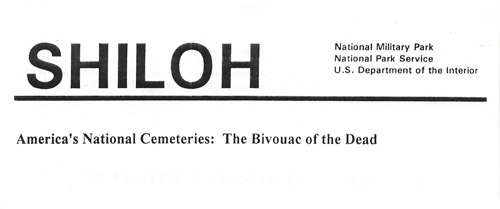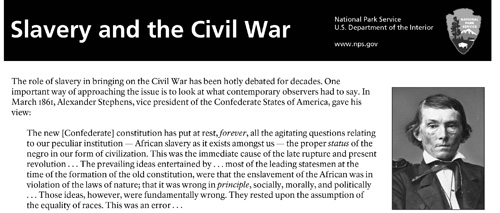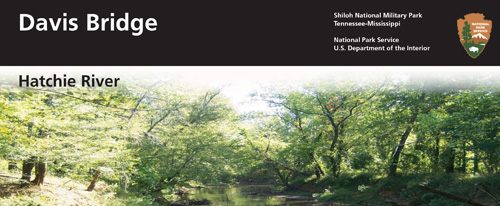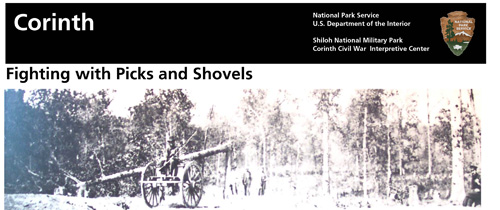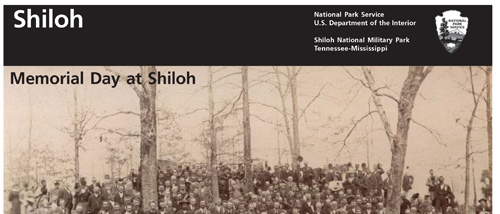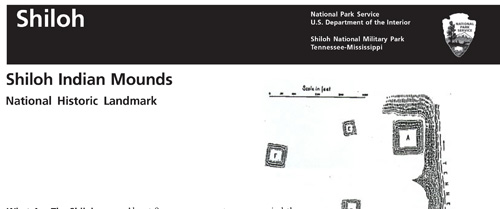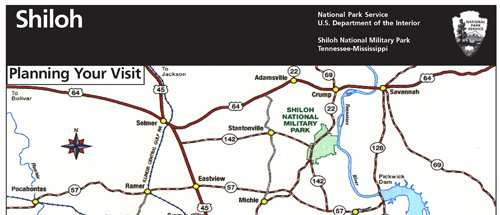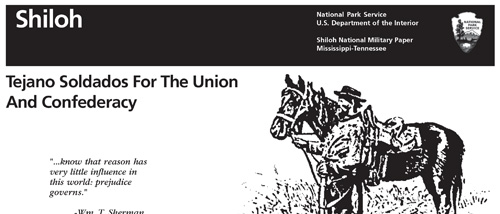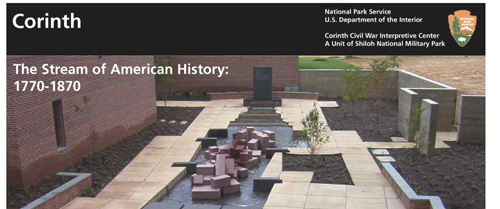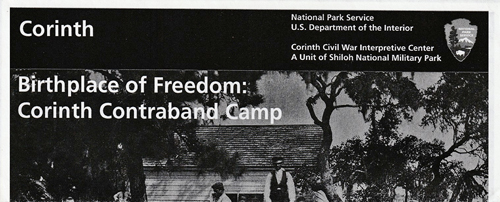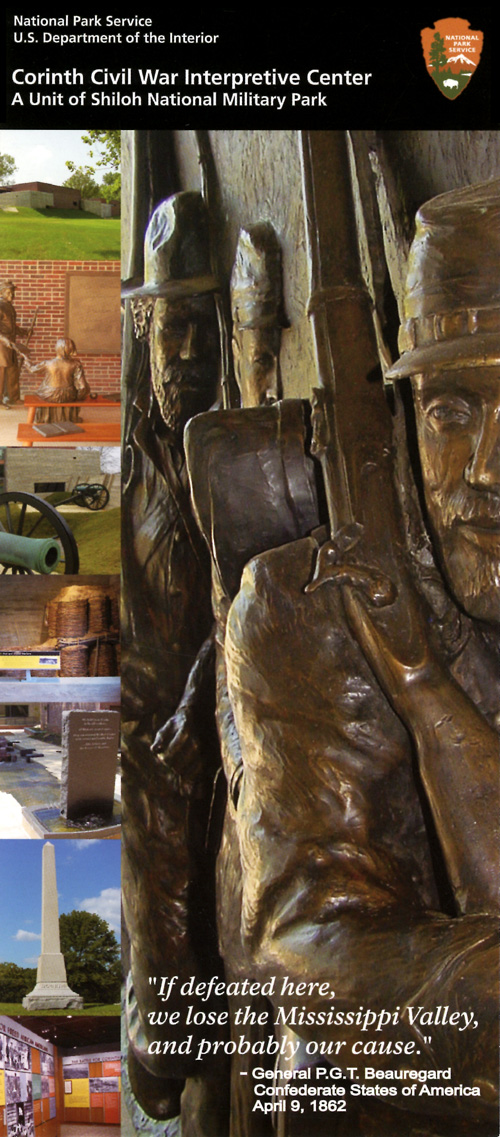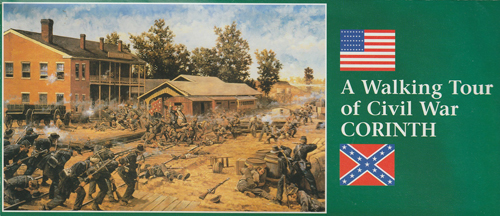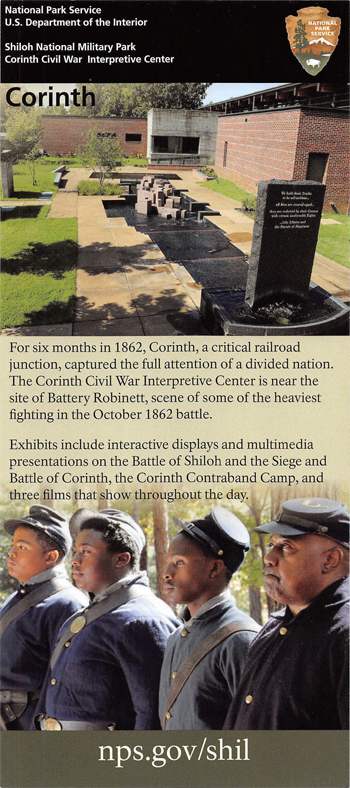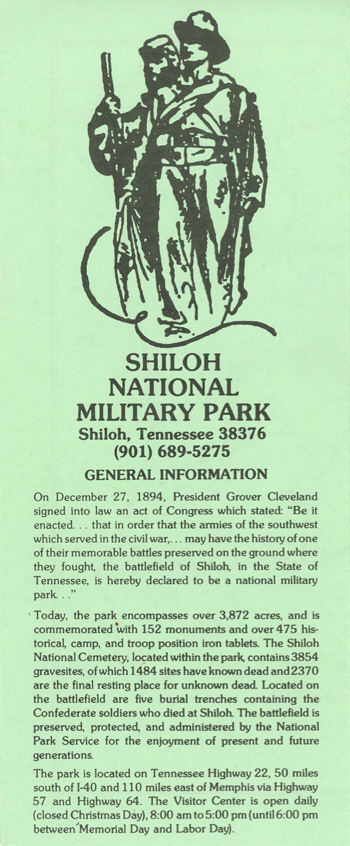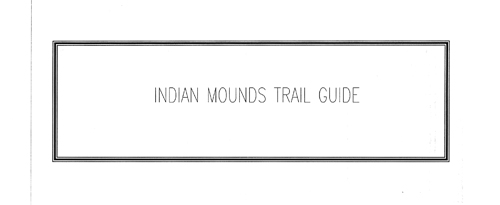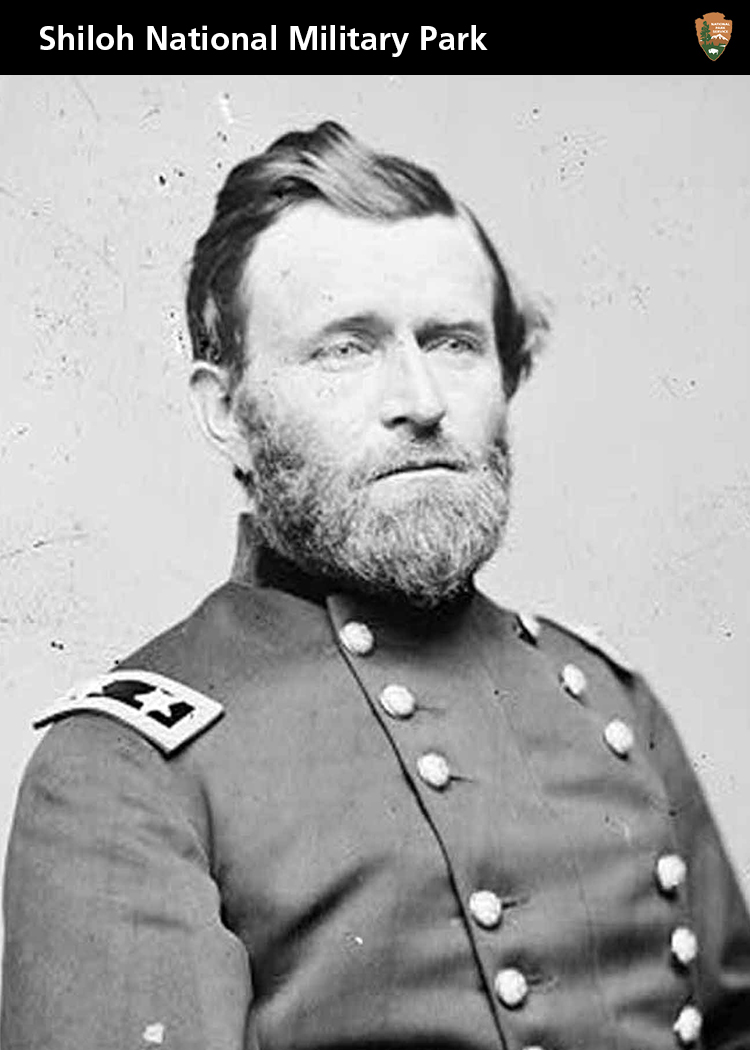|
Shiloh National Military Park Mississippi-Tennessee |
 |
 NPS photo | |
"The ground was strewn with the dead of the enemy and our own, mangled in every conceivable way."
—Capt. Samuel Latta, 13th Tennessee Infantry, C.S.A.
Shiloh
Gen. Ulysses S. Grant's capture of Forts Henry and Donelson in February 1862 forced Gen. Albert Sidney Johnston, Confederate commander in the area, to abandon Kentucky and Middle Tennessee. To prevent a Union advance into the Mississippi valley, Johnston concentrated his forces at the strategic railroad hub at Corinth, Miss. Meanwhile, in mid-March, Grant steamed up the Tennessee River, disembarking at Pittsburg Landing, 22 miles northeast of Corinth. Ordered to wait for Don Carlos Buell's Army of the Ohio marching overland from Nashville, Grant prepared to advance on Corinth.
Johnston, however, seized the initiative, leading 44,000 men against Grant. At dawn, April 6, a Federal patrol discovered the Confederates and desperate fighting engulfed the Union camps in the forest and fields around a small log church called Shiloh Meeting House. Grant's 40,000 men stubbornly contested the onslaught, and unparalleled slaughter resulted. General Johnston, who was among the casualties, bled to death from a leg wound, and Gen. P.G.T. Beauregard assumed Confederate command. Grant's divisions, pressed back nearly two miles, still held the important river landing, where Buell's vanguard arrived at nightfall. Reinforced overnight with thousands of fresh troops. Grant counterattacked in the morning.
For six hours, outnumbered Confederates fiercely resisted until they could hold no longer. To save the army, Beauregard ordered a retreat to Corinth. The battered Federals did not pursue. Shiloh's 23,746 casualties forecast an increasingly bloody and protracted war, leaving in doubt the question of who would control Corinth's railroad junction.
"Our lines melted under their fire like snow in thaw."
—Edward H. Cummins, captain & acting inspector-general, C.S.A.
Corinth
Henry Wager Halleck, commander of Union forces in the West, considered Corinth's capture of supreme importance. On April 29, leading over 100,000 men, Halleck cautiously advanced southwest from Pittsburg Landing. By late May his soldiers were entrenched within cannon range of Confederate fortifications defending the strategic crossroads. Despite being reinforced by Gen. Earl Van Dorn's Army of the West, Beauregard withdrew south to Tupelo, abandoning the most viable line of east-west rail communications in the western Confederacy.
In late summer 1862, Confederate leaders launched counter-offensives in every theater. In the West, armies led by Gens. Braxton Bragg and Edmund Kirby Smith invaded Kentucky, while Van Dorn boldly attacked the heavily fortified Union garrison at Corinth, commanded by Gen. William S. Rosecrans. Some of the heaviest fighting took place in and around Union Battery Robinett. Although Confederate troops managed to fight their way into town, Van Dorn was decisively repulsed. His retreating army engaged a Federal force at Davis Bridge on October 5, but managed to evade complete destruction. These three days of carnage (October 3-5) produced 4,838 Confederate and 3,100 Union casualties.
Van Dorn's devastating defeat, coupled with Bragg's retreat from Kentucky after the Battle of Perryville (October 8), caused discouragement in Richmond and great relief in Washington. More significantly, Van Dorn's defeat at Corinth—the last Confederate offensive in Mississippi—seriously weakened the only mobile Southern army defending the Mississippi valley. Ulysses S. Grant was now free to launch a relentless nine-month campaign to capture Vicksburg and regain control of the Mississippi River.
Highlights of the Civil War in the Western Theater, 1861-64
Lincoln elected, South secedes; Fort Sumter
bombarded; war begins
November 1860-April 1861
Confederacy controls the railroad junction at
Corinth, Miss.
February 1861
Union forces capture Forts Henry and Donelson, and
Nashville, Tenn.
February 1862
Union forces occupy Pittsburg Landing, Tenn.
March 1862
Battle of Shiloh/Pittsburg Landing, Tenn.
April 1862
Siege and capture of Corinth, Miss.
April-May 1862
Engagement at Iuka, Miss.
September 1862
Battle of Corinth, Miss., and engagement at Davis
Bridge
October 1862
Grant's first attempt to capture Vicksburg, Miss.,
fails
October-December 1862
Contraband Camp for ex-slaves set up at Corinth,
Miss.
November 1862
Emancipation Proclamation January 1863
Campaign, siege, and surrender of Vicksburg, Miss.
January-July 1863
U.S. forces abandon Corinth, Miss.
January 1864
"If defeated here we lose the Mississippi Valley, and probably our cause."
—Gen. P.G.T. Beauregard
After the Battle of Shiloh, Confederate Gen. P.G.T. Beauregard cabled this haunting prediction to his superiors in Richmond. A month later, with Union forces moving to besiege the critical railroad junction at Corinth, his adversary. Northern commander Gen. Henry W. Halleck, shared similar sentiments with Union Secretary of War Edwin M. Stanton: "Richmond and Corinth are now the great strategical points of war, and our success at these points should be insured at all hazards."
Two of the most important railroads in the Confederacy passed through Corinth. The Memphis & Charleston linked the Mississippi River to the Atlantic seaboard by way of Chattanooga. This line was so vital to the Southern war effort that former Confederate Secretary of War Leroy Pope Walker called it the "vertebrae of the Confederacy." The second line, the north-south Mobile & Ohio, connected Columbus, Ky., with Mobile, Ala. Their intersection made Corinth the most strategic transportation hub in the western Confederacy. Its loss would play havoc with lateral communication between Richmond and the crucial western theater for the rest of the war.
When the Civil War began, Corinth boasted over a thousand residents, many businesses, five churches, three hotels, and Corona College, a school for young women. Though most people in the area had opposed secession, Corinth became a mobilization center for Mississippi volunteers in 1861, and tens of thousands of soldiers passed through the town. In early 1862, as simultaneous Union offensives penetrated the upper South, driving Confederate forces southward. Gen. Albert S. Johnston chose Corinth to assemble western Confederate forces and mount a counter-offensive.
Roughly 22 miles northeast of Corinth, the small settlement of Pittsburg Landing, Tenn., lay on the west side of the Tennessee River. Area residents subsisted off small farms carved from old-growth forest, and worshiped at a local Methodist meetinghouse called Shiloh. The undeveloped country roads linking the Pittsburg steamboat landing to the Corinth rail junction were the primary routes over which river commerce arrived or departed by wagon. Also, the landing was the southernmost river point serviceable to steamboats at both low and high water. In March 1862, Gen. Ulysses S. Grant came up the Tennessee with a Union army to sever the western Confederate railroads and move into the Mississippi valley. Pittsburg Landing, on the northern tip of a high plateau well-suited for camping tens of thousands of soldiers, provided the logical base of operations for the planned Federal offensive against Corinth.
With Johnston concentrating Confederate forces at Corinth to resist invading Union armies and Grant selecting nearby Pittsburg Landing as his base for mounting a decisive operation against western Confederate railroads, the stage was set for a titanic battle somewhere between these two communities.
Touring Shiloh Battlefield
The battlefield tour starts at the visitor center, where exhibits and a 32-minute film introduce the battle and the war. Maps highlight troop movements of the armies before and during the two-day battle. Used with the tour map, they help orient you to the ground where the action took place and make the tour stops more meaningful. The visitor center is open daily except Thanksgiving, December 25, and January 1.
Grant's Last Line The artillery along this ridge marks the final position of Grant's line on April 6. From this front, the Federals launched their counterattack on April 7.
Confederate Monument This memorial commemorates where Confederate troops encircled and captured nearly 2,100 Union defenders of the Hornet's Nest.
Duncan Field Union troops defended this position for seven hours on April 6, before finally giving ground. They retook it in the counterattack the next day.
Ruggles' Battery When infantry attacks against the Hornets' Nest failed, the Confederates concentrated 11 batteries of artillery to bombard the position, allowing their infantry to encircle and capture Gen. Benjamin Prentiss and nearly 2,100 Union soldiers.
Shiloh Church Here stood Shiloh Meeting House, the log Methodist church that gave the battle its name.
Rhea Field Exposed to converging fire from the Federal troops defending Shiloh Church, Confederate units here sustained devastating losses in repeated attacks across Shiloh Branch on April 6. The 6th Mississippi Infantry, for one, suffered 70-percent casualties.
Fraley Field The short trail west of this stop leads to Fraley Field where fighting commenced. The battle began here at 4:55 am, April 6, when Confederate pickets engaged a patrol from Col. Everett Peabody's brigade.
Confederates Gain Ground Early on April 6, Prentiss' division deployed along the low ridge in front of you to try to halt the Confederate onslaught. The Federals were soon forced back to their camp
Invasion of the Union Camps Prentiss' soldiers briefly defended their camps before retreating north at 9 am. Johnston's offensive stalled when his soldiers stopped to plunder supplies.
Hornets' Nest Parts of three Federal divisions stubbornly defended this densely wooded area on April 6, so named by attacking Confederates because of the stinging shot and sheli they faced here.
Shiloh's Casualties One of five known mass graves where many of the 1,728 Confederate dead were buried. Shiloh veterans considered these graves important aspects of battle history.
Jones Field Union forces rallied here at noon on April 6, mounting a counterattack that briefly checked the Confederate offensive. Next day, fresh Federal troops drove the Confederates from the field.
Water Oaks Pond The desperate assaults Gen. P.G.T. Beauregard hurled through this pond on April 7 failed to halt Grant's counteroffensive. With chances for victory gone, Beauregard withdrew his army to Corinth.
Field Hospital Here Federal surgeons set up one of the first tent hospitals of the Civil War. By concentrating medical services on the battlefield, patient care was greatly improved and the death rate lowered.
Death of General Johnston Struck by a stray bullet, Gen. Albert Sidney Johnston died in the ravine south of this monument. P.G.T Beauregard succeeded to command of the army.
The Peach Orchard Sarah Bell's orchard was in full bloom when Confederate troops attacked Union forces here on April 6. The Federals eventually retreated to Pittsburg Landing, but retook the field during the counterattack the next day.
Bloody Pond Throughout the battle, soldiers of both sides came here to drink and bathe their wounds. Both men and horses died at the pond, their blood staining the water.
Dill Branch Ravine Wooden U.S. gunboats, Lexington and Tyler, anchored opposite the mouth of Dill Branch to support General Grant's defense of Pittsburg Landing.
Grant's Left Flank Here Union artillery hammered the flank of Confederate infantry charging across rugged Dill Branch ravine.
Pittsburg Landing Gen. Don Carlos Buell's Army of the Ohio arrived here on the night of April 6-7 to reinforce Grant.
 (click for larger map) |
For Your Safety
Make your visit safe and enjoyable. Motorists, hikers, and bikers share
park roads; be alert and cautious. • Do not climb on cannon,
monuments, or fences. It damages them and it is dangerous for you.
• Use good judgment when near the river bank. • For firearms
laws and policies, see the park website.
Accessibility We strive to make our facilities, services, and programs accessible to all. For information go to a visitor center, ask a ranger, call or check our website.
Corinth Siege and Battle
Shiloh National Military Park's Corinth Unit contains 14 historic sites associated with the siege, battle, and occupations of Corinth, Miss., during the Civil War. Throughout the war, Confederate and Union troops built miles of earthworks to guard the approaches to Corinth from the north, south, east, and west. Several miles of rifle pits, trenches, and artillery positions still exist. Other points of interest include the 20-acre Corinth National Cemetery, the final resting place for nearly 6,000 Union soldiers who fought at and around Corinth. Several historic homes, like Hamilton Mask's "Verandah House," which served as headquarters for Confederate and Union generals, are located in town. All of these sites, plus Davis Bridge Battlefield 18 miles northwest of Corinth near Pocahontas, Tenn., are accessible by automobile.
Corinth Civil War Interpretive Center
The Corinth Civil War Interpretive Center is near the site of Battery Robinett, scene of some of the heaviest fighting in the October 1862 battle. Exhibits include interactive displays and multimedia presentations on the Battle of Shiloh and the Siege and Battle of Corinth, and "Crossroads," a feature film depicting the war's impact on local civilians.
The culminating interpretive feature is a commemorative courtyard where stone and flowing water chronicle the birth and growth of the United States, the accompanying rise of sectionalism, key events leading to the Civil War, and a symbolic representation of four years of war. At the base of the courtyard, a reflecting pool offers a chance to contemplate the war's meaning and significance. The Center also contains a research library and bookstore.
The Corinth Civil War Interpretive Center is open from 8 am to 5 pm every day except Thanksgiving December 25, and January 1. There is no admission fee.
Corinth Contraband Camp
The security offered by United States forces occupying Corinth after May 1862 attracted enslaved African Americans who fled plantations and farms seeking freedom. The migration of these people (first called "contraband of war") into occupied Corinth increased dramatically following President Abraham Lincoln's Preliminary Emancipation Proclamation. Issued in September 1862, it authorized, as of January 1, 1863, freedom for all slaves in areas then still in rebellion against the United States.
To accommodate these refugees. Union Gen. Grenville M. Dodge established a camp northeast of town. What began as a tent city in late 1862, by mid-1863 had blossomed into a thriving community of homes, a school, church, hospital, and a progressive cooperative farm program. Northern white men and women from abolitionist and benevolent organizations came to Corinth to provide the freedmen with religious, academic, and vocational instruction.
The camp, considered a model of its kind, served as a temporary home for 6,000 former slaves during its operation. After implementation of the Emancipation Proclamation, African American men in the camp were enlisted in the Union Army. This led to the formation of the 1st Alabama Infantry Regiment of African Descent (later re-designated the 55th United States Colored Infantry). Nearly 2,000 African American men who passed through the camp enlisted in the Union Army. The contraband facility was closed in December 1863, one month before Union forces abandoned Corinth, and moved to Memphis, where the freedmen resided in a more traditional refugee facility for the remainder of the war.
The contraband camp was the first step on the road to freedom and the struggle for equality for thousands of former slaves. The park preserves a small portion of the historic Corinth Contraband Camp site, which is open daily 8 am to 5 pm.
Shiloh Indian Mounds National Historic Landmark
About 800 years ago, a town occupied the high river bluff at the eastern edge of the Shiloh plateau. Between two steep ravines, a wooden palisade protected large earthen mounds and dozens of house sites. Six flat-topped mounds around a plaza probably served as platforms for important structures like a chief's house or a religious building. A dome-shaped burial mound south of the plaza held remains of important residents. The Missouri flint clay effigy pipe, found here in 1899, is on display at the Tennessee River Museum in Savannah, Tenn.
Shiloh is one of the few places in the eastern United States where the surface remains of prehistoric houses are still visible. This prehistoric town was the center of a society that occupied a 20-mile stretch of the Tennessee River valley. Because these people left no written record, many questions about the Shiloh site remain unanswered. Archeological evidence indicates the town was abandoned for some unknown reason several hundred years before the arrival of the first European settlers. What became of the mound builders who once lived here remains a mystery.
In addition to this site, the Shiloh chiefdom included six smaller towns, each with one or two mounds, and isolated farmsteads on higher ground along the river valley. Downstream, on the river's eastern bank, Savannah, Tenn., is the site of another palisaded settlement with multiple mounds Many of the Savannah mounds were built much earlier, about 2,000 years ago, but the site was reoccupied at roughly the same period as the Shiloh village. Modern development has obliterated most of Savannah's prehistoric town.
Tennessee River Museum
Exhibits at this museum in Savannah, Tenn., chronicle prehistoric life in the river valley, the lives of the Mississippian mound builders, the tragic story of the "Trail of Tears," the Civil War on the River, the Golden Age of Steamboats, and the role the river plays in the lives of people today. The museum is a 20-minute drive from Shiloh Battlefield. It is open from Monday to Saturday, 9 am to 5 pm, and Sunday, 1 pm to 5 pm. Children are admitted free. The adult admission fee is waived for those presenting a valid Shiloh park receipt.
Source: NPS Brochure (2014)
|
Establishment Shiloh National Military Park — December 27, 1894 |
For More Information Please Visit The  OFFICIAL NPS WEBSITE |
Brochures ◆ Site Bulletins ◆ Trading Cards

Documents
A History of Shiloh National Military Park (1954)
Administrative History, Shiloh National Military Park (Liz Sargent, Deborah Slaton and Timothy Penich, June 2018)
Cultural Landscapes Inventory: Shiloh National Cemetery / Shiloh National Military Park (2020)
Cultural Landscape Report: Shiloh National Military Park 85% Draft (Quinn Evans, April 2021)
Excavations at Mound A, Shiloh National Military Park, Tennessee Southeastern Archaeological Conference Bulletin 23 (Lindsay M. Beditz and Randy V. Bellomo, extract from Proceedings of the Thirty-Sixth Southeastern Archaeological Conference, 1980)
Exotic Woody Plants of Shiloh National Military Park, Tennessee: A Population Survey of Aggressive Species NPS Research/Resources Management Report No. 51 (Teri Butler and Peter S. White, September 1981)
Foundation Document, Shiloh National Military Park, Tennessee-Mississippi (April 2016)
Foundation Document Overview, Shiloh National Military Park, Tennessee-Mississippi (January 2016)
Geologic Resource Evaluation Report, Shiloh National Military Park NPS Natural Resources Report NPS/NRSS/GRD/NRR-2018/1778 (Trista L. Thornberry-Ehrlich, October 2018)
Historical Base Map, Shiloh National Military Park and Cemetery, Shiloh, Tennessee (Edwin C. Bearss, August 1973)
Land Protection Plan, Shiloh National Military Park, Tennessee-Mississippi (2002 Biennial Review)
Long-Range Interpretive Plan, Shiloh National Military Park (January 2009)
National Register of Historic Places Nomination Forms
Indian Mounds (Robert Nash, April 15, 1975)
Shiloh Indian Mounds Site (Mark R. Barnes, June 6, 1988)
Shiloh National Military Park (Robert Nash, March 27, 1975)
Siege and Battle of Corinth Sites (Paul Hawke,, Cecil McKithan, Tom Hensley, Jack Elliot and Edwin C. Bearss, February 12, 1992)
Natural Resource Condition Assessment, Shiloh National Military Park NPS Natural Resource Report NPS/SHIL/NRR-2017/1387 (Andy J. Nadeau, Kevin Benck, Kathy Allen, Hannah Hutchins, Anna Davis and Andrew Robertson, February 2017)
New Lands Development Concept Plan, Shiloh National Military Park Newsletter (May 2024)
Occupied Corinth: The Contraband Camp and the First Alabama Regiment of African Descent, 1862-1865 (Joseph E. Brent, February 1995)
Oral History Interview Transcripts, Interviews conducted on behalf of the Shiloh National Military Park Administrative History (Liz Sargent, May 2018)
Ozone and Foliar Injury Report for Cumberland Piedmont Network Parks Consisting of Cowpens NB, Fort Donelson NB, Mammoth Cave NP and Shiloh NMP: Annual Report 2009 NPS Natural Resource NPS/CUPN/NRDS-2010/110 (Johnathan Jernigan, Bobby C. Carson and Teresa Leibfried, November 2010)
Shiloh National Military Park, Tennessee: Historic Handbook No. 10 (HTML edition) (Albert Dillahunty, 1955)
Soil Survey of Shiloh National Military Park, Tennessee (2013)
Special Resource Study: Corinth Unit, Shiloh National Military Park, Mississippi-Tennessee (December 2003)
State of the Park Report, Shiloh National Military Park, Tennessee-Mississippi State of the Park Series No. 25 (2016)
The Siege and Battle of Corinth: A Strategy for Preservation, Protection and Interpretation (September 1991)
Books

shil/index.htm
Last Updated: 21-Aug-2024




















